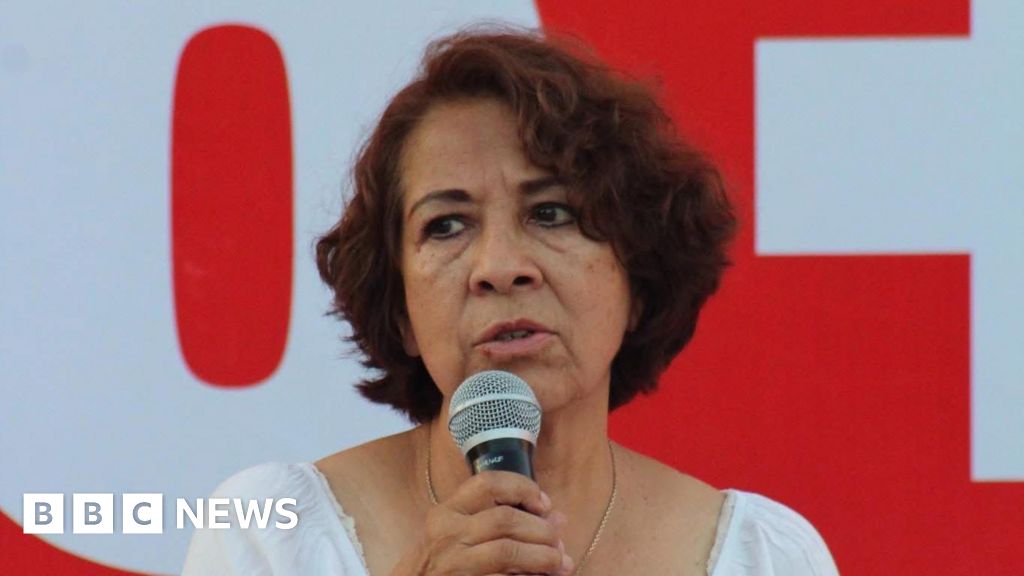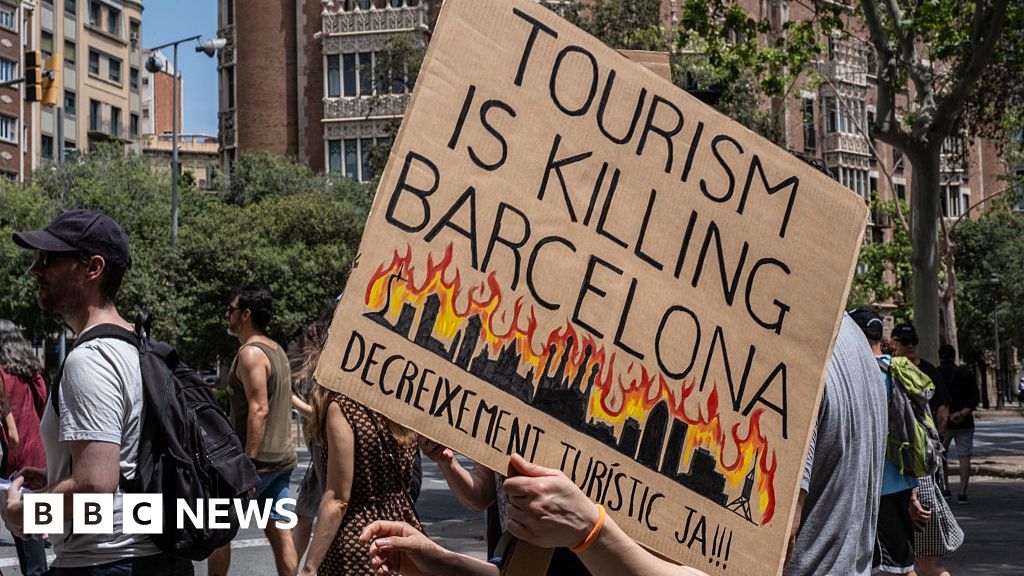ARTICLE AD BOX
Image source, Washington Post via Getty
Image caption,Albright served as an ambassador to the UN and as US secretary of state
Born as Maria Jana Korbelova in Prague, Czechoslovakia in 1937 - Madeleine Albright was known to her family first as Madla, then Madlenka. It wasn't until the 1950s that she officially became, as she described it, a "thoroughly American Maddy" when she got US citizenship.
Diplomacy was always in her family. When Albright was born her father, Josef Korbel, worked for the Czech government in Belgrade.
After the Nazis invaded their home country in 1939, Korbel fled with his family to London and continued to work for the Czech government in exile while doing broadcasts with the BBC.
After the war, he returned home to serve as an ambassador and later became a UN delegate to help mediate between Pakistan and India in Kashmir. But as communism took hold of his home country, Korbel again feared for his family's safety. He successfully applied for political asylum for him, his wife, and their three children in the US - where he received a grant to teach politics in Denver, Colorado.
'Family tragedy comes to light'
It was not until many years later, in the late 1990s, that Albright learned just how vulnerable her family's position in Europe had been.
The Washington Post newspaper discovered more than a dozen of her relatives, including three grandparents, were killed during the Holocaust for being Jewish. Albright, who was raised Roman Catholic, had until then been unaware of the circumstances of their death.
By the time Albright moved to the US, aged 11, she had already lived in several countries and spoke four languages. In her memoir, she recalled struggling to fit in with other American teenagers - dogged by "strict and uptight" European parents who found the culture alien and her own serious streak when it came to her studies.
Image source, Sygma via Getty Images
After high school, a scholarship allowed her to study political science at Wellesley, a private women's university in Massachusetts that Hillary Rodham Clinton would also later attend.
It was during this time that Albright first became interested in Democratic politics and met her future husband, Joseph Medill Patterson Albright, from a famous US publishing family.
He worked as a young reporter while she was cutting clips at the Denver Post newspaper as an intern. Within weeks, the pair were engaged.
After Albright graduated from Wellesley, the couple got married and started a family. They first had twin daughters, Alice and Anne, in 1960. A third daughter, Katherine, followed in 1967.
Image source, Sygma via Getty Images
Image caption,Madeleine Albright (centre) working on a student newspaper at Wesley College in 1958
Joseph continued to pursue his career while his wife learned Russian and furthered her international relations studies in her spare time, first at Georgetown and then at Columbia University in New York.
It was in the late 1960s, when the family returned to Washington DC, that Albright first became directly involved with politics. She worked closely with Maine Senator Ed Muskie, first helping him fundraise for a presidential run and then as his legislative assistant.
Albright eventually completed her PhD in 1975. A few years later she was offered her first job in government by Zbigniew Brzezinski, her former university professor at Colombia. He had been named as National Security Advisor by President Jimmy Carter and wanted his former student to help him liaise with Congress.
When the Democrats eventually lost power to Ronald Reagan, Albright transitioned into working for non-profits. By this time, Albright's husband had abruptly ended their marriage after 23 years.
She threw herself into work, becoming a professor of international affairs at Georgetown. As faculty, she made her students role-play foreign policy situations. She made a point of putting women into the male-dominated roles, teaching them the importance of speaking up and interrupting to have their voices heard.
Image source, Getty Images
Image caption,Some of Albright's own research focused on dissident journalism in Poland
"My classes may have been a little boisterous," she wrote in her memoir. "But the women learned and the men got used to it".
While teaching, Albright kept her finger on the pulse of Democratic politics. Her Georgian townhouse became a social hub and venue for political meetings, with Albright serving as a foreign policy adviser on the presidential campaigns of both Walter Mondale and Michael Dukakis.
'Fourteen suits and a skirt'
When Bill Clinton was elected in 1992, he first asked Albright to help with his administration's transition before offering her the cabinet-level role as his ambassador to the United Nations. Albright was confirmed in the Senate unanimously.
Her appointment came at a formative time for the UN. The world was reeling from the downfall of communism and a number of bloody conflicts tested the hand of an international body still finding its feet.
Image source, White House via Getty
Image caption,Albright (left) seen with members of Bill Clinton's national security team in 1993
At the time, Albright was the sole woman among 15 representatives on the Security Council. She described their first meeting as 14 suits and a skirt in a room.
It was during this time, as ambassador, Albright experienced what she called the "deepest regret" of her career - the failure of the international community to halt the genocide in Rwanda.
On the world stage, Albright advocated aggressively for US and democratic interests. Perhaps aided by her all-too close familiarity with communism and fascism, she was a fierce proponent of human rights and opposition to authoritarianism on the international stage, even if it meant military intervention.
Making history
After winning a second term in office, President Clinton nominated Albright as his Secretary of State.
"When my name came up to be Secretary of State, you would think that I was an alien," she told the Guardian newspaper in 2018. "People actually said: 'The Arabs won't deal with a woman'."
Image source, Getty Images
Image caption,Albright, seen greeting Palestinian leader Yasser Arafat, at her Georgetown home in 2000
But after another unanimous confirmation vote, Albright became the 64th person - and first woman - to hold the role.
While in office, Albright advocated for the increased influence of Nato and helped broker Israeli-Palestinian peace negotiations.
She was also heavily involved in negotiations with North Korea aimed at curbing their nuclear ambitions, though they ultimately failed.
Image source, AFP
Image caption,Albright met with the North Korean leader in Pyongyang
Albright's no-nonsense, and sometimes combative, diplomatic approach occasionally raised eyebrows.
In 1996, Cuban fighter jets shot down a pair of planes from a US-based exile group group. Radio recordings showed one of the Cuban pilots had boasted: "We took out his balls" as they downed it.
Ambassador Albright, referencing the Spanish word for testicles, told the media: "Frankly, this is not cojones; this is cowardice."
She successfully lobbied the UN to say it strongly deplored the attack, which US data proved had happened in international airspace. Clinton would later declare Albright's cojones quote as "probably the most effective one-liner" in his administration's foreign policy strategy.
'Read my pins'
Albright also had a unique diplomatic technique of her own too: the use of accessories.
She said she was first inspired by Iraqi media comparing her to an "unparalleled serpent" for her treatment of Saddam Hussein after the first Gulf war.
"I had this wonderful antique snake pin. So when we were dealing with Iraq, I wore the snake pin," she told NPR in 2009.
Image source, Getty Images
Image caption,She described her extensive brooch collection as an "icebreaker" to discussions
She decided this would be a fun way to communicate her diplomatic feelings going forward. For Albright turtles, flowers and balloons all had their own subliminal interpretations.
On one occasion, Albright wore a giant insect brooch when the Russians were embroiled in a "bugging" scandal. On another, she recalled a frosty encounter with President Vladimir Putin over a "see no evil, speak no evil, hear no evil" monkey broach she donned to convey a message on Russia's activities in Chechnya.
After leaving office after the turn of the millennium, Albright started a consulting firm and briefly served as a board director on the New York stock exchange. She continued to chair institutions, speak publicly, and even made cameos as herself on US television shows.
Image source, Alamy
Image caption,The former secretary of state appeared on Parks and Recreation and Gilmore Girls (pictured)
She also continued to advocate politically.
Having already established a close relationship with her as first lady, Albright endorsed Hillary Clinton during her 2008 and 2016 presidential campaigns.
At one event, she infamously recounted one of her favourite idioms that "there is a special place in hell for women who don't support other women".
Albright also continued writing and public speaking into her final years.
In 2018, aged 81, she published Fascism: A Warning in which she decried what she saw as a rise of authoritarianism across the globe. While promoting it around the world, she repeatedly described Donald Trump as the "least democratic" president the US had ever seen.
She died surrounded by her family, aged 84, and is survived by her three daughters and her grandchildren.

 3 years ago
32
3 years ago
32








 English (US) ·
English (US) ·